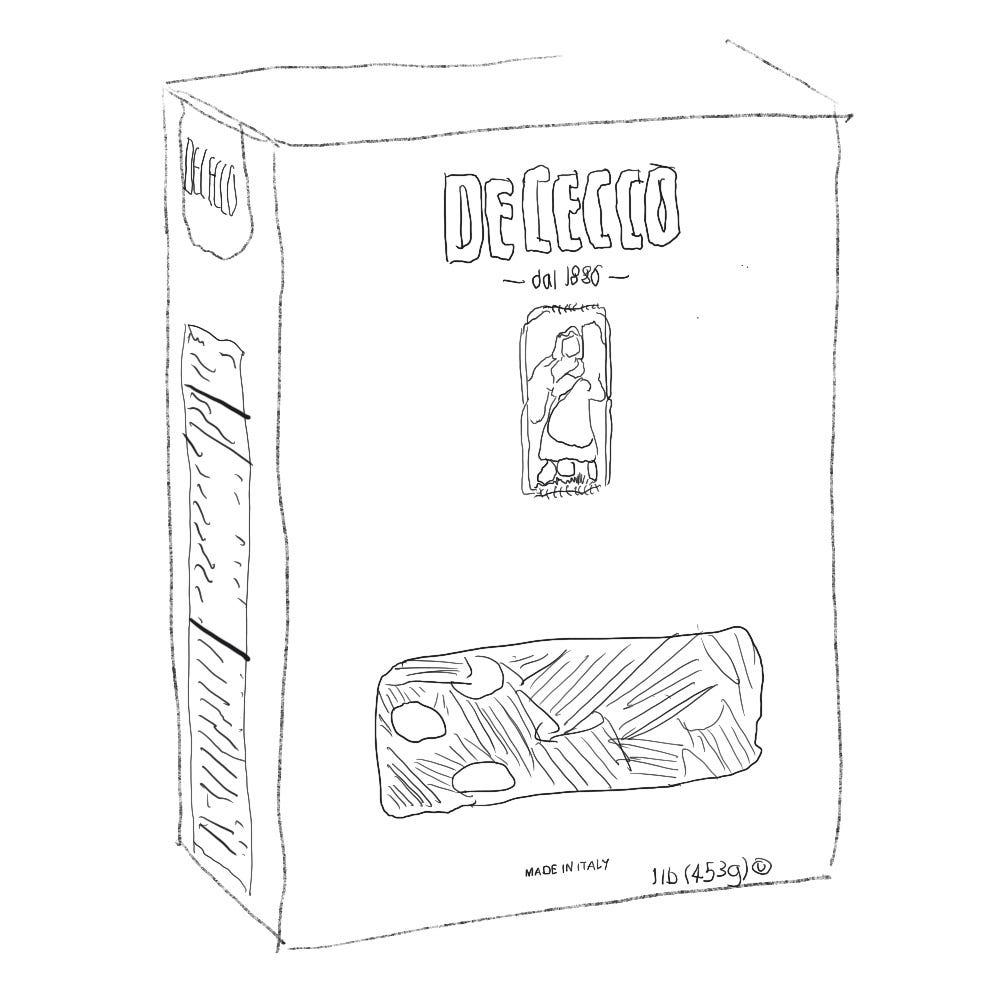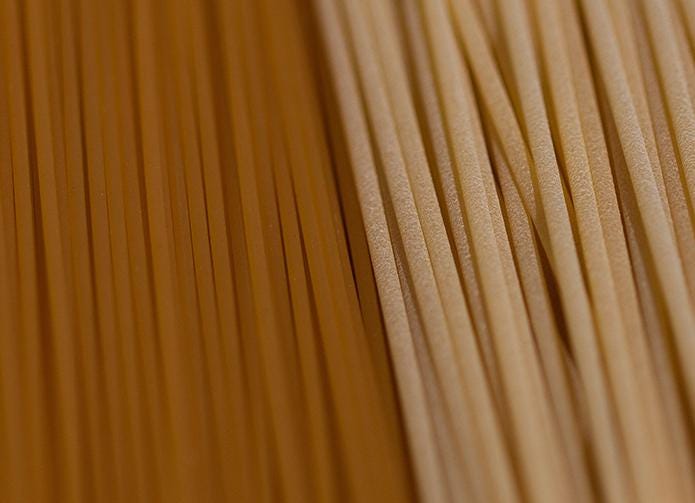Thank you to all 100+ of you who joined us so far!
Walking past one of the trendiest pasta restaurants in Toronto on garbage day, I was shocked by the mountains of empty De Cecco boxes they had put out for recycling. Sugo is a lot of people’s favourite Italian spot, with a reputation for considered cooking. After “running” into one of the owners at my run club, he told me about how De Cecco uses bronze dies and I got curious.
Pasta is fascinating. I love when the simplest of things gets elevated to a level of obsession. Like having the exact right tool for a job, there is great satisfaction in having the right noodle for your sauce.
Kevin introduced me to the joy of bucatini for pasta and meatballs. FAR SUPERIOR TO SPAGHETTI. The heft of the hollow noodle stands up to the sauce/meatball onslaught to really give every bite an amazing full mouth feel.
When people think about pasta, they divide between fresh and boxed pasta. Fresh is this incredible yet time consuming, luxurious, celebratory dish. If you have slept on boxed pasta, now is time to reconsider.
You have to know what to look for, which is why we are here! Amazing boxed pasta does not require a trip to a specialty store. What is fascinating, to me at least, is that one of the boxes on the grocery store shelf is just as good as some of the options that are 10x the price. Let’s dig into a bowl of De Cecco research.
Design
Dating back to 1886, De Cecco is a company that is older than modern Italy. Started out of a grain mill in Fara San Martino, close to the Adriatic Sea in the Abruzzo region of Italy, the company is still family run and produces Pasta in this same region.
I was not the first person to discover DeCecco. Frank Sinatra loved their pasta so much that in the 60’s he offered to buy the company for $1M. The family countered with an offer of $7M and he balked.
What makes De Cecco unique is that they are one of the largest manufacturers of pasta that still uses bronze dies. Pastas is an extruded product, which means that a dough is forced through a mold and cut at set intervals. Ever squish play doh through a screen? That is a crude form of extrusion.
Most major pasta manufacturers have long switched to using Teflon coated dies or other smooth, precision milled tools. These precision tools lack gaps or crevices, so they last much longer and are less prone to clogging (and also make pasta cheaper to make). The problem is that they cannot create a textured surface on the extruded product. Slick perfect noodles. That’s bad! Each little crack and crevice in a noodle is a perfect spot for sauce to stick.
Innovation
The big homie Don Filippo Giovanni De Cecco, of the moustache and button hole adornment, was responsible for innovation that made mass pasta production possible. Before him, all pasta was local because you could not dry it and ship it en masse! Abruzzo, where the De Cecco’s lived in Italy, had great soil and weather for growing wheat, but the climate was too harsh for drying pasta. Once the pasta is extruded, it needs to be left to dry so it can be stored and shipped. How pasta dries has a huge effect on the quality of the end product. Pasta that has been dried too fast and too hot just releases all of it’s gluten when it hits boiling water and tastes and feels more like wet flour than delicious fresh bread.
Filippo was the first to build a drying shed. He invented a system where the pasta was put on trays that were fed into an aspirated machine that allowed him to create drying routines, mixing hot and cold like a traditional Italian daylight cycle. His innovation allowed for lower temperature and slower drying that created a superlative end product. His methods are now the standard for better pasta production.
Sustainability
Great things happen with tight relationships with a business and a place. Filippo cared so much about his little corner of the world, he ran and became mayor of Fara San Martino in the early 1900s. More importantly, De Cecco has been able to capitalize on regional advantage to drive down their environmental impact. By being seated adjacent to their raw input production (the wheat) and near readily available hydro electric power (which powered their mill in the 1800s and now drives a power plant they own), they are able to build an integrated supply chain model with little waste. No one is perfect (and their Italian site makes no mention of it) and De Cecco has been known to import wheat from Arizona and California (so called desert wheats), which allow them to up the protein in their dough without altering the colour and texture. It is a small percentage compared to the local wheat they use.
Shipping boxed pasta all over the world is definitely not sustainable. If you have a better, local source, that will keep your hard earned dollars in the community, that is usually a preferable option. Still, on the balance these folks seem to be doing a good job.
In reading about pasta, I came across an interesting tangent. SWERRVE. In the early 2010s, Guido Barilla, the patriarch of the Barilla family (the worlds largest pasta producer and the other blue box), made some anti gay comments on Italian radio. There was a huge consumer boycott and the company has since changed its ways, including receiving a number of awards from LGBTQ causes for their turn around and approach to diversity. I loved this because so often I wonder if when I try and make a statement with how I spend, if anyone notices. This was a great validation that how we choose to spend our money has a huge impact! They do use teflon dies though.
Cost
At less than $3 per box, it is a very affordable everyday luxury. I was unable to find a bronze die extruded, hard semolina pasta for less. If you really want to go wild and explore artisanal dried pastas, this is not like collecting Ferraris. Even the most expensive ones at my local Eataly still come in at less than $10. MANGIA!!
Hope you enjoyed this! Hit Reply or leave a comment and let us know. If you have anythings you want us to look into, just let us know (and why)!
A footnote about Sustainability and Sustainability Reporting:
DeCecco issues a report on their environmental footprint and contributions to the community. The industry term is CSR. In this case, I had to sift through a Google Translate version from Italian to English to learn about their production methods but we do it for you! An interesting factoid is they have even been able to reduce water consumption by 30% in the last five years.
While Kevin and I were chatting this through, he made a great point. For a company that is owned by a family, why do they need to do CSR reporting? It isn’t to satisfy the markets, because they do not get a say in how the De Cecco’s make the pasta. Interesting that they are still committed to having the discussion.
De Cecco only has 23 shareholders (all family members, no less). It looks, from the outside, like they really care about their product and how it is produced. They fired the only non-family CEO for not being aligned with their local and regional commitments (as per a Google translated excerpt of their of Italian Wikipedia page).









Now I really want pasta
What a fun read! Now I can buy boxed pasta and STILL feel luxurious ;) If only the same could be said for other foods. Thx for sharing.